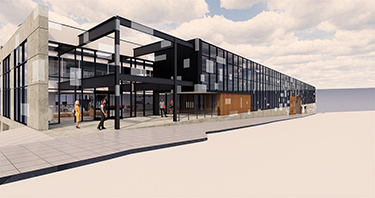|
Subscribe / Renew |
|
|
Contact Us |
|
| ► Subscribe to our Free Weekly Newsletter | |
| home | Welcome, sign in or click here to subscribe. | login |
Real Estate
| |
 |
August 25, 2022
Catalysts for change: buildings that reinvigorate our cities
B+H Advance Strategy

Demers
|
Our downtowns are sitting in the eye of the perfect storm. Swirling around them are investors making net zero commitments, regulators developing reporting standards, companies rethinking workplace needs, tenants demanding healthier buildings, and the imperative of digital transformation.
When the storm passes it will leave in its wake a different landscape. One that will be characterized by what the financial industry refers to as the “Great Repricing;” a recalibration of value that will see many assets devalued, some stranded, and others coming out on top.
The revitalization of our cities will not happen on a massive scale. It will be achieved through the innovative reimagining of existing buildings that catalyze the emergence of vibrant micro neighborhoods and communities.
There are exceptionally exciting opportunities for those willing to take a long hard look at their real estate portfolio and invest in their preferred future. Existing buildings are, by their very nature, the most sustainable buildings we have. With some foresight and imagination, an existing asset can be strategically repositioned to serve long into the future.
We’ve developed a checklist of fundamental considerations for positioning your existing portfolio for long term success.
The five elements of a catalyst building:
1. Create connection. Historically our downtown buildings have stood as monoliths; self-contained and aloof. Understanding who and what surrounds your asset and creating connections between activities and services, plugs your building into a network where it becomes an indispensable node.
2. Establish a brand identity. The ebb and flow of human activity craves an anchor. Sustainable buildings are rooted in their location. They connect users deeply to the unique characteristics of their environment. Memorable identities are created when the DNA of local history and geography is translated and fused with the aspiration of the community you are striving to create.
3. Embrace the natural world. There is an increasing body of evidence that supports the positive mental and physical wellness benefits of healthy buildings. Buildings that let in natural light, provide access to the outdoors, are filled with natural materials and greenery, are sought after by tenants and demand significantly higher rents.
4. Be climate ready. Real estate accounts for approximately 39% of total global emissions. As companies seek to mitigate their carbon footprints and tenants increasingly vote with their feet, buildings that can demonstrate best practices in resource consumption and decarbonization will be in demand.
5. Leverage technology. AI, big data, machine learning and predictive analytics are powerful tools in any real estate portfolio. From building operations and management to successful marketing and tenant communications, a technology strategy that supports your building’s goals is a critical tool in optimizing ROI.
As the financial and regulatory environment shifts in step with tenant and user expectations, assets that can demonstrate a thoughtful, holistic approach to repositioning will be the long-term winners.
Doug Demers is managing principal at Seattle, at B+H Advance Strategy, a consulting practice.
Other Stories:
- Small towns and sustainable growth
- Legislation provides new opportunities for energy conservation projects
- Creativity is hallmark for 555 Tower
- Using GIS to support equitable community development
- Real estate companies need to think creatively
- Finding the path to zero with resilient urban design
- How to create a compelling destination
- Sammamish’s new Town Center will build community



